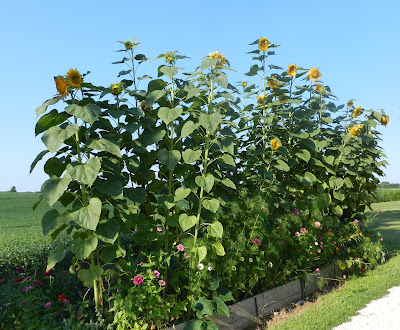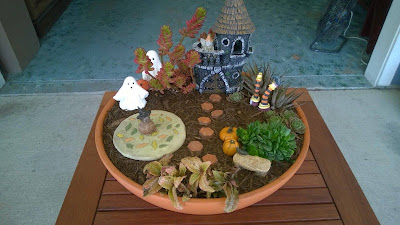I see
numerous articles about planting gardens for specific pollinators. Especially popular right now is butterfly and
bee gardens.
You can
have plants that are especially attractive or needed by specific pollinators
but an excellent pollinator garden will try to satisfy many pollinators.
I can tell
an experienced gardener from a social gardener by their tolerance for the less
attractive pollinators. It’s easy to
love butterflies and not as easy to love wasps.
Some
insects need nectar producing plants for long tongues and others plants for
short-tongued insects.
Other
insects need certain plants for the different development stages and not for
nectar and pollen at all. Plus, you
have to be willing to tolerate some leaf and plant damage if it’s used at the
caterpillar stage of development.
All insects
must have their specific needs met at the specific time of the year and specific
to their development stage.
Although
there are many plants that prove enticing to pollinators, here are some I’ve
found easy to grow in my yard and they’ve helped increase pollinator activity.
Any kind of
squash (including pumpkins and ornamental gourds.) The pollinators go crazy over the flower
pollen.
Fall
blooming asters are another pollinator food.
Plant herbs
such as rue, chives, thyme, marjoram, catmint, other mints, yarrow, parsley,
basil, lemon balm, lavender, hyssop, borage, germander, sage, savory,
chamomile, rosemary, dill, betony, lamb’s ears, thyme and dandelion. These are used by both bees and butterflies.
Hummingbirds
and bats are also pollinators and they will flock to the herbs bee balm,
lavender, pineapple sage, hyssop, mints, rosemary, catnip, comfrey, mallow and
globe thistle.
Encircling
your vegetable garden with herbs will help seduce pollinators to those
vegetable plants, too.
People
often say they are leery having plants where stinging insects might interact
with humans. If you are allergic to
specific insect stings, you may not be the person to have a large pollinator
garden. If you aren’t allergic, this is
what I’ve found: If I don’t bother them
while they’re in the process of pollinating, they don’t bother me.
Use
milkweed (Asclepias syriaca) in the garden early enough to provide the only
plant Monarch Butterflies use for laying their eggs. 85% of all monarchs feed on these in their
caterpillar stage. www.pollinator.com
Here's
some of Pollinator information:
ü 20,000 – number of species of wild
bees. Some species of butterflies,
moths, wasps, beetles, birds, bats and other vertebrates also contribute to
pollination.
ü 75% - Percentage of the world’s food
crops that depend, at least in part, on pollination.
ü $235 to $577 Billion US dollars –
Annual value of global crops directly affected by pollinators.
ü 300% - Increase in volume of
agricultural production dependent on animal pollination in the past 50 years.
ü Almost 90% - Percentage of wild
flowering plants that depend to some extent on animal pollination.
ü 1.6 million tonnes – Annual honey
production from the Western Honeybee.
ü 16.5 % - Percentage of vertebrate
pollinators threatened with extinction globally.
ü Over 40% - Percentage of
invertebrate pollinator species (particularly bees and butterflies) facing
extinction.
ü 90% of all wild flowering plants
depend, at least to some extent, on animal pollination.
ü Pollinators also contribute to the
pollination of plants used for biofuels, fibers, medicines, forage for
livestock and construction materials.
Will your
little garden make a difference in the pollinator population? Not a huge difference. BUT will lots of little gardens, set aside
farmland planted with prairie plants, stopping the indiscriminate use of
pesticides and not mowing all the roadsides, waterways and wooded areas before
insect and wildlife finish their birthing process will make a difference.
The
Genetically Modified (GM) food crop issue is a hotly debated one and the
research isn’t nearly done or currently understood. One of the biggest threats to pollinators
through GM crops is the loss of weeds.
“Duh” you say! Weeds in field
crops reduces yield, takes away from the end price and often makes picking
difficult. Often these weeds were the
necessary food or breeding plant for pollinators. However, they do not now have an
understanding of the risk (direct or indirect) to pollinators of the chemicals
themselves.
Moving away
from traditional (think grandpa) farming practices and no longer having
foodstuffs raised in all home gardens are cited as a major impact upon
pollinators. While pointing fingers at
crop farmers may be convenient for the internet reading population, assigning
blame for those of us who no longer raise all our own vegetables and fruits
ranks right up there, too. We must
realize it’s no one thing threatening pollinators; it’s a combination of
cumulative things.
The good
news is farmer, garden and public land management practices are reducing the
risks to pollinators. An example is
while managed bees have been struggling, the wild bee population is holding
firm. Since crop yields depend on both,
the wild bees are contributing to the stability in pollination.
Many
farmers are also reducing pesticide usage, seeking alternative forms of pest
control and adopting a range of specific application practices, including
technologies to reduce pesticide drift.
Are all farmers participating in this?
No, but then neither are all gardeners.
The good news is most farm organizations (members include not only
farmers but the agricultural research universities) are involved in developing
best practices and the distribution of information to help farmers of every
crop find the best way to increase yields, increase profit while protecting the
land.
Some state land
management departments are also participating in alternative methods of
roadside management. I saw wheat planted
down the medium of the interstate out west, poppies in Canada, wildflowers down
south and a general reduction in mowing and turf grass along interstates. Illinois (always the last in the nation to
think about what’s good for it’s citizens) still spends millions of dollars mowing
every roadside. Both spending tax monies
when it could be used elsewhere and deleting an important food and habitat for
pollinators.
With the
exception of California, the general populace has realized yards and roadsides
that look like golf courses aren’t as healthy, beneficial nor as beautiful as a
more diverse landscape.
As
gardeners, it pays to be well informed about the same practices and issues used
in farming. Although our end result
isn’t on as large of a scale, the cumulative good is as important.






























